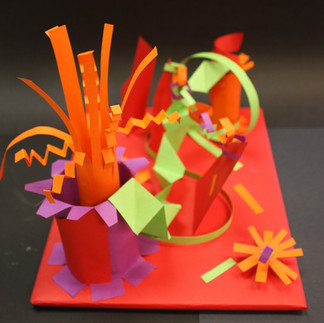How can art therapy support children in coping with the effects of sexual abuse?
- Pranali Arora
- Dec 19, 2024
- 5 min read
Healing from trauma is a deeply personal journey. For children who have experienced sexual abuse, the road to recovery can be especially complicated. Traditional therapy methods may not resonate with young minds, making it essential to explore alternative approaches. One effective option that has gained recognition is art therapy. By merging creative expression with psychological healing, art therapy provides children with a safe space to process their feelings and experiences.
Through art therapy a child may find relief from overwhelming emotions, crises, or trauma; discover insights, achieve an increased sense of well-being. It is a way to make sense of which is painful, to create personal meaning, to enhance wellness, and to become whole. Let us see how art therapy can benefits and support young children coping with sexual abuse.
Understanding Art Therapy
Art therapy blends artistic expression with psychotherapy, allowing individuals to use creativity as a healing tool. This method is particularly effective for children, as it engages their imagination and natural curiosity, acting as a bridge to deeper emotional expression. It is a dynamic therapy, requiring one to participate in one’s own treatment, in this case through art making. Therefore, truly understanding art therapy requires first hand experience.
Children do not need to be skilled artists; instead, art therapy encourages spontaneous and free expression. For instance, a child may find it easier to convey feelings of anger, fear or sadness through a simple drawing rather than through words or using specific colour, or increased pressure (than usual) on the paper while colouring. Research indicates that nearly 70% of children benefited from emotional expression during art therapy sessions.
Providing a Safe Space for Expression
A primary advantage of art therapy for abused children is the establishment of a safe environment. This supportive setting allows them to explore emotions without fear of being judged.
During sessions, children can choose the materials and creative methods they feel most at ease with, promoting a sense of autonomy and control in their healing process. For example, a child may draw an experience and then decides to tear it into pieces or colour it completely to hide the image they have drawn using a black colour paint. Some might prefer painting over cut-and-paste activities which can help them express experiences on their terms. This flexibility is crucial for fostering healing and trust.
Facilitating Emotional Awareness
Many children who experience sexual abuse struggle to understand and articulate their feelings. Engaging in art therapy can help develop emotional awareness. In recent studies, children who expresses emotionally laden event through drawing are able to verbally recollect and relate more details about their experiences than through talking alone. Art therapy creates a safe and non-judgmental environment where individuals can express their feelings through various artistic mediums such as drawing, painting and sculpting.
Through the artistic process, children can visualize complex feelings such as anger, sadness, or confusion. For instance, a child may create artwork using dark colours to represent feelings of anxiety, allowing them to confront and process emotions they might not yet fully understand. Studies show that children who participate in art therapy report a 60% improvement in identifying and expressing their feelings.
Encouraging Communication
Art can often communicate what words cannot, particularly for children dealing with tough subjects. Emotions, particularly those that result from sexual abuse are hard to articulate. Repressed emotions may eventually lead to depression, anxiousness, helplessness, or frustration. Art marking can be particularly beneficial in circumstances where overwhelming or complex emotions needs to be expressed. In art therapy, children may produce images that symbolize their trauma, opening the door to conversations with the therapist.
These discussions provide valuable insights into a child’s emotional state, enabling therapists to tailor their approach. For example, a drawing of a stormy sky may indicate feelings of turmoil, leading to focused dialogue about the child’s experiences. The non-verbal aspect of art allows children to share more deeply than they might in a traditional therapy setting.
Building Confidence and Self-Esteem
Surviving sexual abuse can severely impact a child's self-esteem, leaving them feeling powerless. Art therapy provides a pathway to restore confidence and self-worth. As children create and reflect on their artwork, they can take pride in their accomplishments. For instance, by completing a painting or building a model, they nurture a sense of achievement. This confidence can encourage them to explore new hobbies and interests outside of therapy, contributing positively to their overall mental health.
Enhancing Coping Mechanisms
Kids who have faced abuse often lack effective coping strategies. Art therapy not only serves as an immediate emotional outlet but also teaches long-term skills for managing feelings.
By engaging in creative activities, children learn to channel their emotions productively. For example, when feeling upset, they may recall how to create art to process their feelings. This use of art can lead to improved self-regulation, helping them handle future emotional challenges with greater resilience.
Fostering Connection with Others
Art therapy can create opportunities for social connections that may be absent in children who have faced sexual abuse. Eventually group art therapy sessions foster a sense of community among peers who share similar experiences.
These sessions can help children feel less alone, as they realize others understand their struggles. Collaborative art projects can lead to the formation of friendships rooted in shared experiences, promoting mutual understanding and support. Data indicates that nearly 50% of participants in group art therapy report improved social interactions and reduced feelings of isolation.
Bridging the Gap on Trauma
Art therapy is effective in integrating fragmented experiences related to trauma. Sexual abuse can leave children with a disjointed sense of self. The artistic process helps them reconnect these fragments into a coherent story.
As children express their trauma through art, they also work toward building a more positive narrative about themselves and their future. This constructive expression fosters hope and a sense of agency in their healing journey.
A Powerful Healing Tool
Art therapy stands out as an impactful method for supporting children who have experienced sexual abuse. By integrating creative expression, it promotes healing that resonates with young minds.
The benefits of art therapy extend beyond expression. It helps build emotional awareness, enhances communication, rebuilds self-esteem, and fosters healthy coping mechanisms. In a world that can feel chaotic, art therapy offers a sanctuary where children can begin their healing process, empower themselves, and find a path toward a brighter future.
Recognizing the importance of art therapy, caregivers, therapists, and educators can advocate for its inclusion in treatment programs. This ensures that survivors of sexual abuse receive the essential support they need to heal—one stroke of the brush at a time.
References:
Malchiodi, C. A. (Ed.). (2011). Handbook of art therapy. Guilford Press.
Abbing, A., Ponstein, A., van Hooren, S., de Sonneville, L., Swaab, H., & Baars, E. (2018). The effectiveness of art therapy for anxiety in adults: A systematic review of randomised and non-randomised controlled trials. PloS one, 13(12), e0208716. Image courtesy: google and online websites































Comments